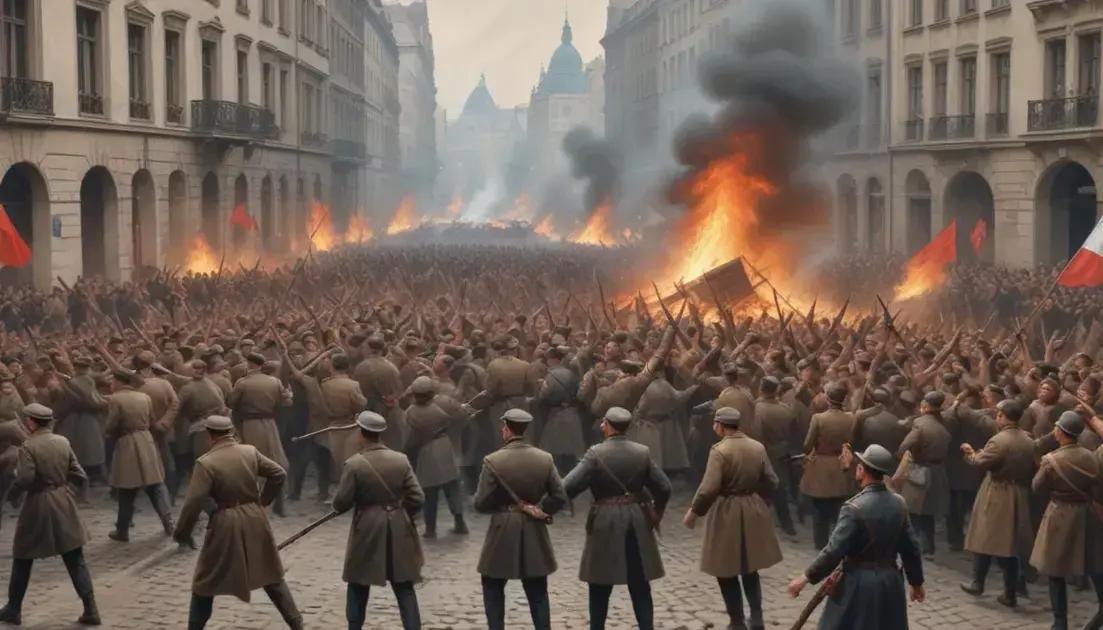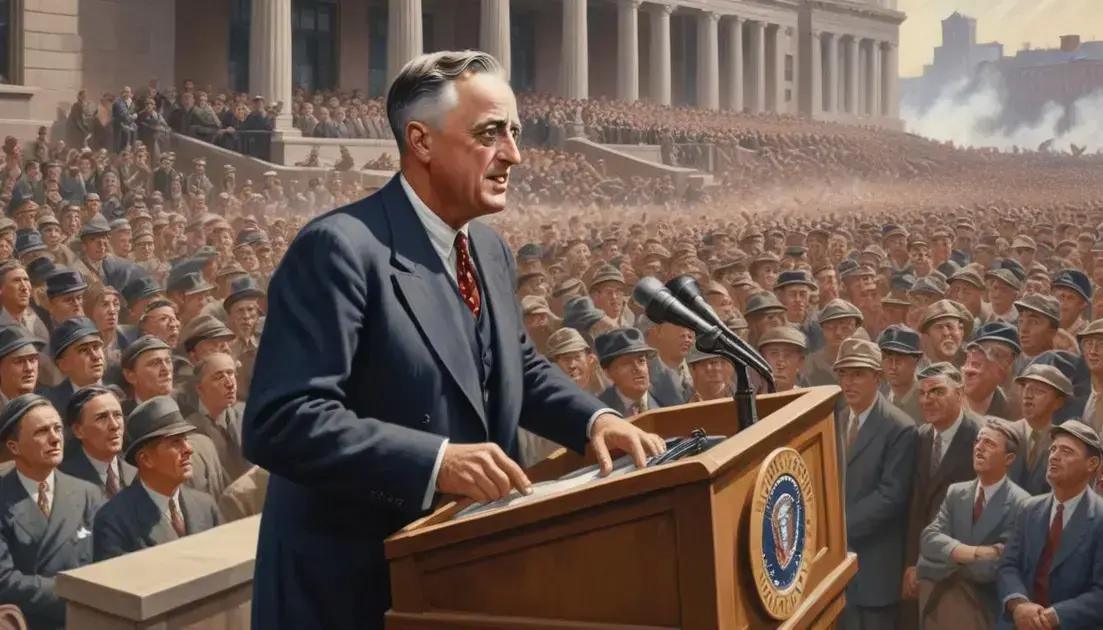
Hungarian Uprising of 1956: Freedom vs Soviet Dominance
The Hungarian Uprising of 1956 was a significant revolt against Soviet control, where citizens truly fought for freedom and democracy. Despite the uprising being brutally suppressed by Soviet forces, it inspired human rights movements worldwide and emphasized the importance of resistance against oppression. Its legacy continues to influence struggles for liberty, highlighting the courage of those who stood up against tyranny.
The Hungarian Uprising of 1956 was a pivotal moment that shook the foundations of Soviet influence in Eastern Europe. Wondering what sparked this fervent fight for freedom? Let’s dive into the events that unfolded!
Background and historical context
The Hungarian Uprising of 1956 was a major event in history. It occurred during a time when many nations were under Soviet control. People in Hungary wanted freedom and democracy. They were unhappy with the Communist government. Citizens took to the streets to demand change.
Historical Background
After World War II, Hungary fell into the hands of the Soviets. The government imposed strict rules, and many freedoms were lost. The economy struggled, and people lived in fear. By 1956, discontent was growing, and the call for reform was loud.
On October 23, 1956, thousands of Hungarians began to protest. They wanted to end the Soviet influence and establish a democratic government. The protests quickly spread across the country. It was a brave move that shocked the world.
The Soviet Union initially seemed to waver. They pulled back their troops briefly. But the hopes of the Hungarian people were short-lived. By November 4, the Soviets launched a brutal assault to crush the uprising.
This uprising was not just about politics. It was about the right to live freely. Many people lost their lives, but their fight for freedom inspired others. The Hungarian Uprising remains a symbol of resistance against oppression.
Key events of the uprising
The Hungarian Uprising saw many key events that shaped its course. The protests began on October 23, 1956, in Budapest. Thousands of students and workers demanded changes. They wanted a new government and freedom from Soviet control.
Many took to the streets. They marched to the Parliament building, chanting for change. The students were soon joined by factory workers. The crowd grew larger every hour. This was a sign of the people’s unity and strength.
The government gave in a little at first. They announced reforms and promised better conditions. However, the people were not satisfied. They wanted complete independence from the Soviet Union.
On October 24, the protests turned more intense. Tanks rolled into the streets, but they did not stop the rising anger. Crowds clashed with soldiers. People fought bravely, refusing to back down.
By November, the situation escalated. The Soviets decided to take action. On November 4, they launched a massive attack. Soviet troops entered Budapest with heavy artillery.
This brutal response crushed the uprising quickly. Many lives were lost, but the spirit of resistance remained strong. The key events of the uprising revealed the brave hearts of Hungarians fighting for their rights.
International reactions
The international reactions to the Hungarian Uprising in 1956 were varied and significant. Many countries watched closely as events unfolded in Hungary. The world was shocked by the violence that came with the Soviet response.
Western nations, especially the United States, expressed support for the Hungarian people. They admired their bravery. The U.S. government condemned the Soviet invasion. However, they did not take direct military action. This left many Hungarians feeling alone in their struggle.
In the United Nations, several countries spoke out. They criticized the Soviet Union for its brutal actions. They called for an immediate ceasefire and urged peace talks. But the Soviet Union ignored these pleas.
Meanwhile, a few countries aligned with the Soviets praised their actions. They saw the uprising as a threat to communist rule. For them, it was important to maintain control over Eastern Europe. They supported the Soviet forces without question.
Some media around the world covered the uprising dramatically. Photos and stories flooded newspapers and broadcasts. This raised awareness of human rights violations within the Soviet sphere. It showed how brave the Hungarian people were in their quest for freedom.
Ultimately, the reactions highlighted a deep divide in global politics. The Hungarian Uprising became a symbol of resistance. The international community was left reflecting on the cost of freedom.
Consequences and aftermath
The Hungarian Uprising had serious consequences for Hungary and the world. After the Soviet forces crushed the protests, many lives were lost. Thousands of people were arrested or executed. The hope for freedom was quickly replaced by fear and repression.
In Hungary, the government tightened its grip. They imposed strict rules and censored all media. This silenced voices that spoke against the government. Many felt hopeless and fearful for their future.
People started to flee the country. Thousands sought asylum in Western nations. They hoped for a better life away from the oppressive regime. This exodus highlighted the desperation of many Hungarians.
Internationally, the uprising changed relationships. Many countries realized how far the Soviet Union would go to maintain control. This led to increased tensions during the Cold War. Nations became more aware of the struggles in Eastern Europe.
The uprising also inspired movements in other countries. It showed that people could stand up against oppression. Activists around the world saw it as a symbol of courage. This led to more support for human rights initiatives globally.
Despite the brutal aftermath, the Hungarian Uprising remains significant. It is remembered as a fight for freedom, showing the human spirit’s resilience. The scars of this event are still felt today, but the memory of the brave fighters lives on.
Legacy of the uprising
The legacy of the Hungarian Uprising is powerful and significant. Even today, it reminds us of the fight for freedom. Though brutally suppressed, the uprising sparked hope and resilience among the people.
One major impact was the inspiration it provided to other movements. Activists around the world saw that it is possible to stand up against oppression. The bravery of the Hungarian people encouraged others to seek their own freedoms.
The uprising also brought attention to human rights issues. Many countries began to recognize the importance of defending individual liberties. It highlighted the need for open discussions about democracy and governance.
In Hungary, the memory of the uprising is honored each year. Commemorative events take place to remember those who fought and died for freedom. Schools teach students about the uprising’s significance and its heroes.
Internationally, the events of 1956 strengthened the resolve of Western nations. They became more committed to opposing Soviet influence in Eastern Europe. This led to increased support for democratic movements in other countries.
Though the uprising ended in tragedy, its message lives on. The spirit of resistance continues to inspire new generations. The legacy of the Hungarian Uprising teaches us the value of courage and the ongoing struggle for justice.
Conclusion
In conclusion, the Hungarian Uprising of 1956 left a lasting impact on history. It showed the world how brave people can be in their fight for freedom. Even though the uprising was crushed, the spirit of resistance continues to inspire.
The lessons learned from this event are important. They remind us of the value of standing up against oppression. The legacy of the uprising encourages us to support human rights everywhere. It teaches us that courage and unity can spark change, no matter the odds.
As we remember the events of the past, we can honor those who fought for a better future. Their bravery reminds us that the quest for freedom is ongoing. Let us carry this message forward and strive for a world where everyone can enjoy their rights and freedoms.


